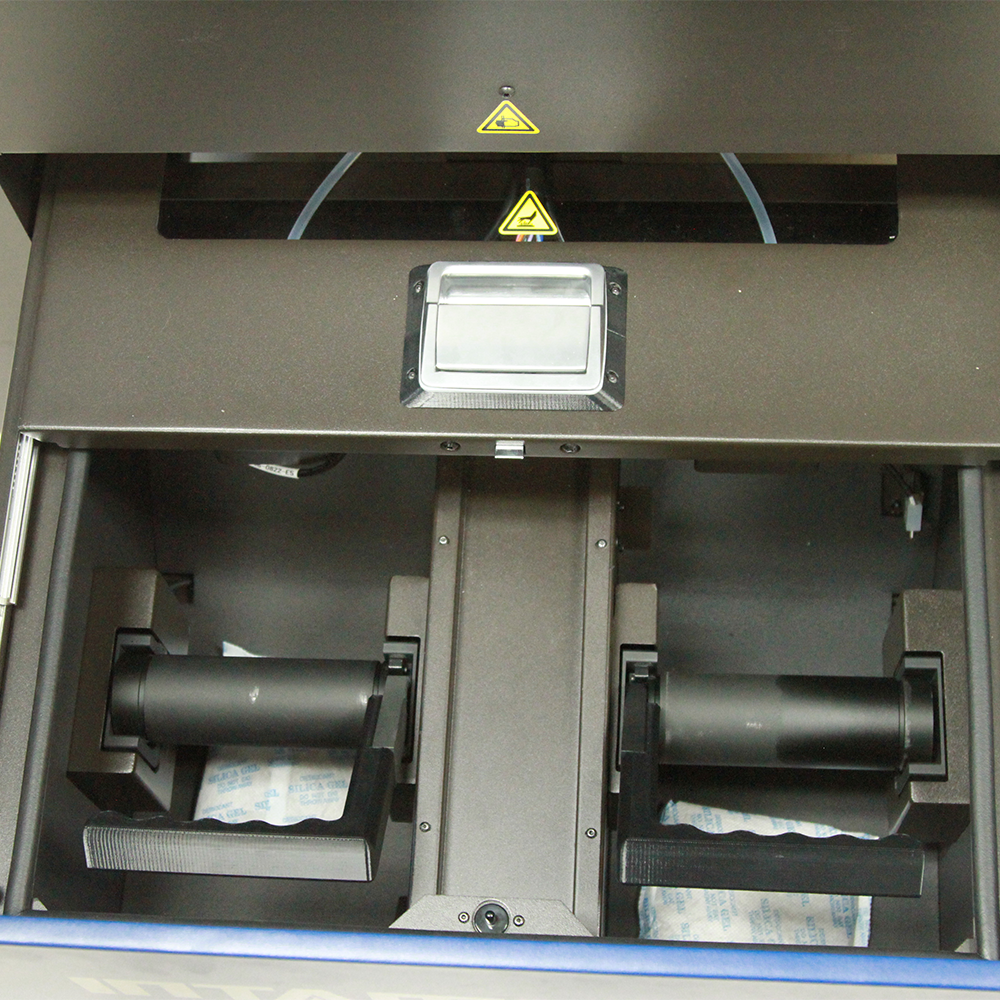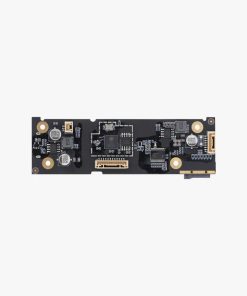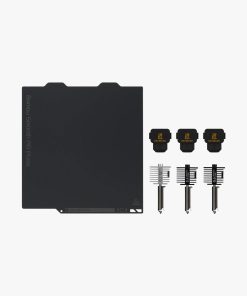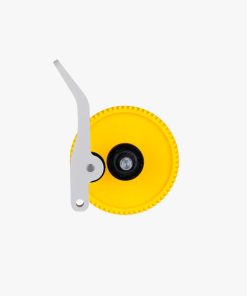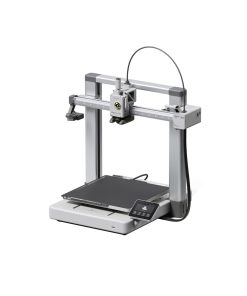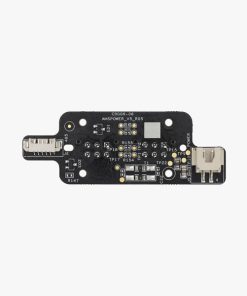Intamsys Funmat Pro 410 3D Printer Intamsys
$ 24.995,00 $ 6.248,75

Intamsys Funmat Pro 410
High-Temperature 3D Printer for High-Demand Applications
The Intamsys Funmat Pro 410 is built to meet high-demand applications at a lower price. The Intamsys Funmat Pro 410 3D printer is capable of reaching 500°C with an actively heated 90°C build chamber. This allows you to print in extremely advanced thermoplastics such as PEEK, PEKK, ULTEM, and many more!
Printing with advanced polymers like these open up new avenues for product design and production. Open up innovation with new materials with better strength-to-weight ratios, mechanical properties, and chemical resistance.


Dual Nozzle 3D Printing

Smart Design for Continuous Production

High-Speed High-Precision

Actively Heated Chamber

Sensor Assisted Automatic Leveling

Multitude of Functional Materials

High Safety Standard
Key Features & Benefits

Smarter Design
Smart dual nozzle 3D printing solutions, automatic leveling, filament jam warning

Industrial-Grade Configuration
Industrial grade components for high-precision and high-quality 3D printing with a large build volume

Advanced Thermal Design
Heated chamber and filament box, liquid hotend cooling system, 500°C (932°F) max hotend temperature

Best-in-Class Safety
Equipped with best-in-class safety components. CE (EMC/RED/LVT) certified for industry-grade application standard
Ease of Use
The Intamsys Funmat Pro 410 is filled with features that make 3D printing incredibly user friendly, ensuring a good user experience. The Funmat 410 has a 7″ touchscreen UI giving you complete control at the tips of your fingers.
The Intamsys 410 also has a host of automation and monitoring features such as automated bed leveling to get an optimal first layer, filament jam sensors to avoid costly clogs that go unnoticed, and filament absence sensors so you can resume your print if you run out of material mid-print. All of this works together to give you a streamlined and simple process for 3D printing.


High Precision Customization & Production
Additive Manufacturing and 3D printing is an incredible tool to create custom-made, high-precision parts at much lower costs than traditional manufacturing methods. You no longer need manufacturing runs in the thousands. With 3D printing you can have production runs of only a single part with low to no added fixed costs. The Intamsys Funmat Pro 410 can enable this low volume custom production with incredibly strong thermoplastics with high precision.
The Funmat Pro 410 3D printer is incredibly precise with a dimensional accuracy of ±0.15 mm per 100 mm. This enables you can create incredibly precise and complex structures that aren’t possible with traditional subtractive manufacturing processes like CNC milling.
Dual Extrusion Supports Complex Models
With a high-temperature dual extruder, the Intamsys Funmat Pro 410 can create intricate and complex parts using purpose-made support materials that easily break away from printed parts or can be dissolved in water or other solutions. This allows you to create parts that aren’t possible with traditional manufacturing methods quickly and easily.
Combining this with the advanced material support of the Funmat Pro 410 allows you to create parts that are lighter and potentially even stronger than traditionally manufactured parts. It also allows a more efficient usage of materials with minimal material waste.


Open Material System with Infinite Possibilities
Intamsys is committed to providing the best 3D printing experience to customers, so they developed their own engineering grade filament solutions designed specifically for printing with the Intamsys Funmat line of 3D printers. In order to truly fulfill their mission of providing the best 3D printing experience possible, the Funmat Pro 410 has an open-source filament system. This means you can use any 1.75mm filament available on the market. Now you can experiment with cutting edge materials, or limit costs by shopping around.
Applications & Use Cases
- Automotive
- Medical
- General Manufacturing
Automotive
Rapid Design Iteration | Spare Parts | Swift Production
Rapid Design Iteration
Engineers can leverage 3D printing technology to quickly create multiple iterations of functional prototypes. These prototypes can be tested for various structural, functional, and material properties. Based on these results, modifications can be made and produced within the same day. 3D printing can significantly reduce time-to-market by streamlining the product design process.
Availability of Spare Parts
Inventory costs of spare parts is a major cost component for automotive manufacturers. Combined with the shortened life cycle of automotive parts, spare part inventories can be hard to manage.
Using 3D printing, auto part manufacturers can shift to virtual inventory. Inventory costs can be cut by maintaining a digital repository of spare part models. Allowing manufacturers to produce parts on demand rather than stock thousands of physical parts. This also allows manufacturers to provide parts and supports for outdated models.
Production Lead Time
3D printing can expedite production lead times and time-to-market by producing parts required in limited, niche quantities. A prime example of this is custom tooling for specific models. Producing small quantities of highly custom parts can be very expensive and take a lot of time. 3D printing can hasten this process exponentially by allowing companies to manufacture these parts in house in the exact quantities necessary.
3D printing can also limit production downtime by speeding up the production of replacement parts and tooling. If a part breaks, a replacement can be manufactured in house the very same day. Traditionally, replacement parts need to be ordered from a 3rd party and could be received weeks later.
Medical
Pre-Surgical Models | Surgical Guides | Custom Implants & Prosthetics
Pre-Surgical Models
The creation of pre-surgical models is one of the major applications of 3D printing by medical researchers and practitioners. 3D printing shines as an informative tool by giving the medical practitioner the ability to print models that exactly match their patient.
Using CT scans, 3D models of an individual’s anatomy can be created. These models can then be printed with a 3D printer. This allows medical professionals to see exactly what is going on inside a patient and more accurately diagnose patients and prepare for surgeries.
Surgical Guides
Surgical guides are another great use for 3D printing in the medical field. Surgical guides are frequently used for the insertion of implants into the human body. They often require a high level of customization to fit each patient’s specific needs.
Intamsys 3D printers can print with chemical stable and safe materials. Perfectly customized surgical guides can quickly and at a lower cost than traditional methods.
Surgical Implants
Surgical implants often require high levels of customization to fit a patient’s body. These custom implants allow patients to enjoy life to the fullest, and are a critical treatment tool. Titanium and PEEK are typically used to create these implants because they are bio-compatible.
Printing surgical implants out of PEEK is easy on an Intamsys 3D printer. Implants 3D printed with PEEK can be created substantially more quickly than titanium. The implants are also much less expensive.
General Manufacturing
Jigs & Fixtures | Rapid Prototyping | Low-Volume Production | Virtual Inventory
Rapid Prototyping & Injection Mold Verification
3D printing can help any company during the design phase, even businesses who utilize mass production. 3D printers enable business to design, produce, and test functional prototypes very quickly. This helps reduce time-to-market of new products and create more well tested products.
3D printing can also help verify injection molding dies. Injection molding dies can be very expensive. Even a single mistake can force companies to order new dies. 3D printing allows companies to print and test both the object and the die itself before ordering. Saving the company potentially thousands of dollars.
Low Volume Production
Due to fixed costs of production, manufacturing low volumes of parts through traditional manufacturing methods can be very expensive and time consuming. 3D printing is the perfect solution to low volume production. Intamsys 3D printers also offer printing with advanced materials with incredible resolution. Meaning you don’t have to sacrifice product quality to create custom, low-volume parts.
Virtual Inventory
Minimizing physical inventory and relying less on overseas supply chains has become an increasingly important practice for companies. Virtualizing inventory into 3D models that can be produced on demand is a solution to both problems. Physical inventory can be made in-house when needed rather than shipped in from overseas.
Technical Specifications
| Intamsys Funmat Pro 410 | |
|---|---|
| Printing Technology | Fused Filament Fabrication (FFF) |
| Machine Size | 728 x 684 x 1480 mm (28.7 x 26.9 x 58.3″) |
| Build Volume | 305 x 305 x 406 mm (12 x 12 x 16″) |
| Build Platform | PI Sheet Heating + Ceramic Glass |
| Leveling | Automatic Leveling |
| Layer Thickness | 0.05 – 0.50 mm |
| Max Travel Speed | XY: 300 mm/s Z: 50 mm/s |
| Print Nozzles | 2 scratch-resistant nozzles |
| Max Extruder Temperature | 500°C (932°F) |
| Max Chamber Temperature | 90°C (194°F) |
| Max Filament Chamber Temperature | 70°C (158°F) |
| Input File Type | STL/OBJ |
| Filament Diameter | 1.75 mm |
| Position Resolution | XY: 16 µm Z: 1.6 µm |
| Smart Monitor & Control | Auto-Cleaning Nozzles, Filament Jam Warning, Filament Absence Warning, Power Failure Recovery, Liquid Cooling System, Over Heat Protection |
| Safety Certification | FCC, SGS, CE |
| Connectivity | WiFi, Ethernet, USB |
| Supported Materials* | PEEK, PEEK-CF, PEEK-GF, PEKK, ULTEM™ (PEI), PC, PC Alloys, PA-HT, PA, PA-CF, ASA, ABS, HIPS, Carbon-Fiber Filled, Glass-Fiber Filled, ESD-Safe, and more |
*Results of part printing may vary depending on material and/or design and size of the printed part.
Professional packing and fast shipping
Due to our longstanding partnership with UPS FedEx DHL and other major global carriers, we are able provide a range of shipping options. Our warehouse staff is highly trained to package your goods exactly as per the specifications we offer. Before shipping the goods are carefully inspected and secured. Everyday we deliver thousands of packages to customers from all over the world. This is a testament to our commitment to be the largest online retailer worldwide. The warehouses and centers for distribution are situated in Europe and the USA.
Orders with more than one item are given processing time for each item.
Before shipping, we will conduct a thorough inspection of the items you've ordered. Currently, most orders are shipped within 48-hours. Expected delivery time is between 3 and 7 days.
Returns
The stock is dynamic and we do not fully manage it because of the fact that multiple stakeholders are involved, including our factory and warehouse. The actual levels of stock can change at any moment. It's possible that the stock may run out after your order has been placed.
The policy is 30 days. If you haven't received the product within 30 days, we are not able to issue a refund or an exchange.
For your item to be returned, it must be unopened and in the same state as you received it in. It must also be in the original packaging.
Related products
3D Printer Parts
3D Printer Parts
3D Printer Parts
3D Printer Parts
3D Printer Parts
3D Printer Parts
3D Printer Parts
3D Printer Parts
3D Printer Parts
3D Printer Parts
3D Printer Parts
3D Printer Parts
3D Printer Parts
3D Printer Parts
3D Printer Parts
3D Printer Parts
3D Printer Parts
3D Printer Parts
3D Printer Parts
3D Printer Parts
3D Printer Parts
3D Printer Parts
3D Printer Parts
3D Printer Parts
3D Printer
3D Printer Parts
3D Printer Parts
3D Printer Parts
3D Printer




